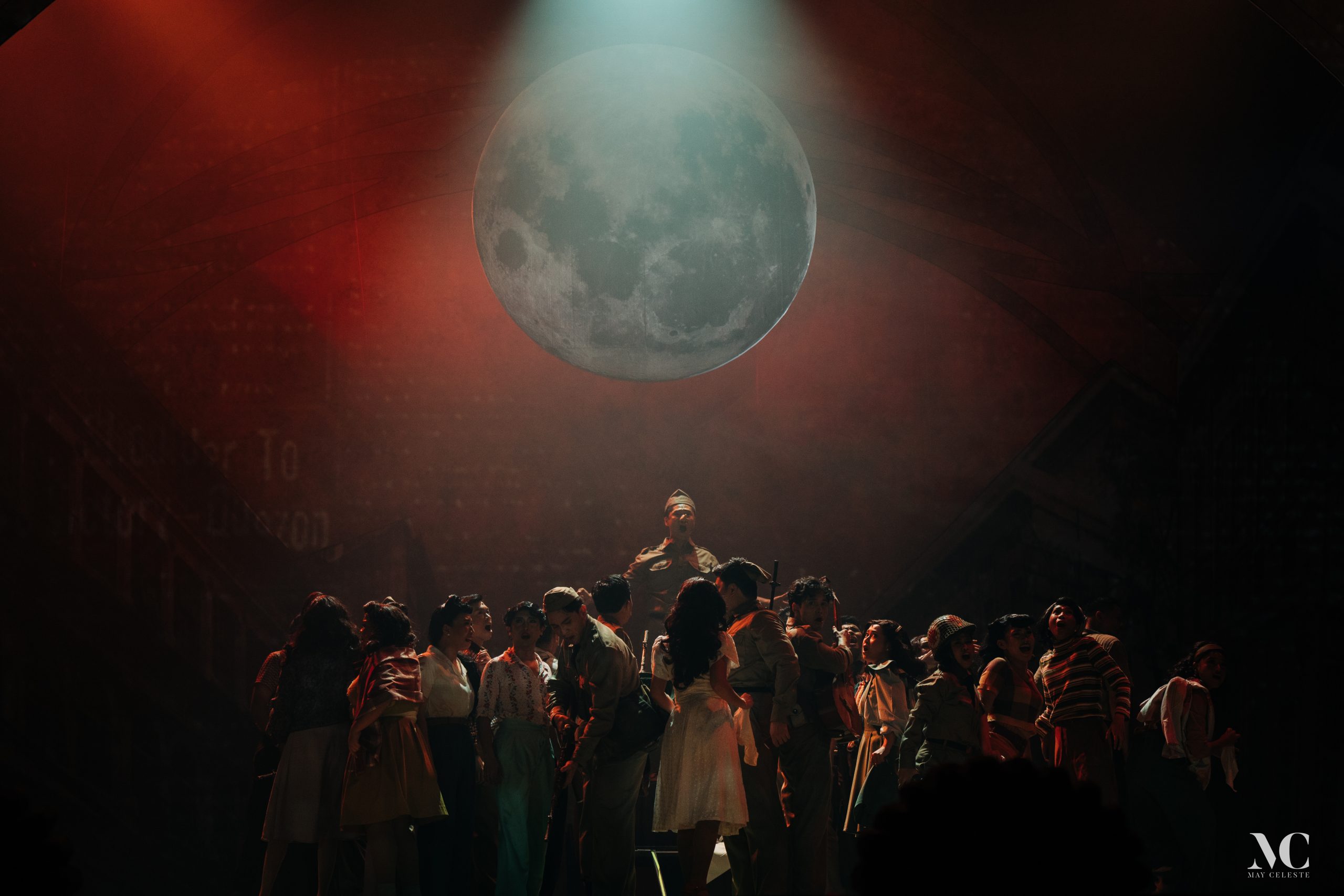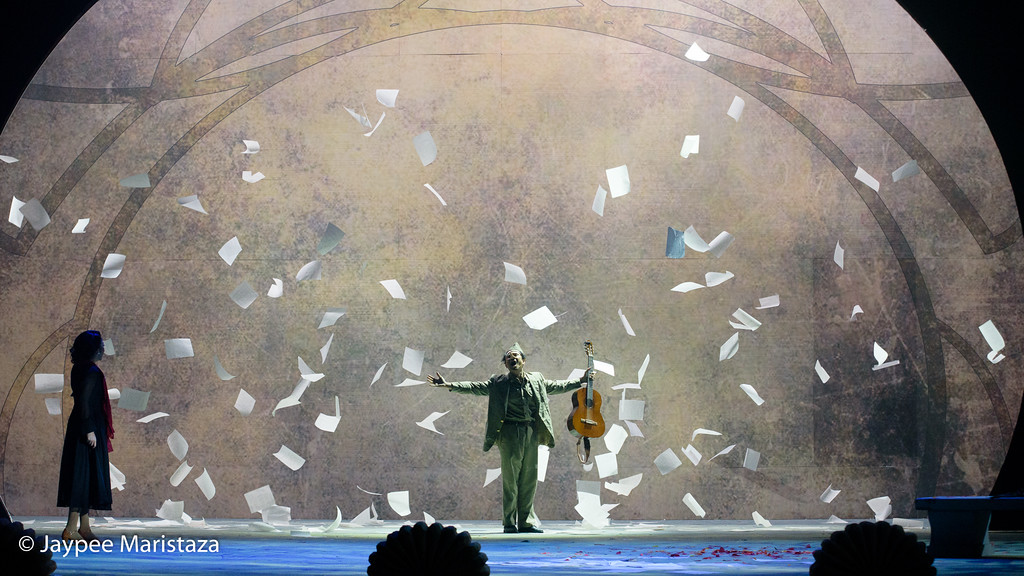
AS MELODIES accompany dance under the dim light on stage, the theater becomes a place where the past can be revived.
Directed by Mikko Angeles, Mula sa Buwan is a play that navigates the delicate balance between historical fact and creative expression, something that involves a fusion of historical remembrance and an imitation of reality.
It combines the elements of musical theater with an unflinching portrayal of history, drawing from the work of Pat Valera and William Elvin Manzano in 2010 from the play Cyrano de Bergerac by French dramatist Edmond Rostand.
Mula sa Buwan follows the stories of Cyrano (Myke Salomon), Roxanne (Gab Pangilinan) and Christian (MC Dela Cruz). The poet Cyrano, who carries a hidden adoration for his childhood friend Roxanne, suffers in silence as he watches her affection shift to another man, Christian.
The characters’ carefree lives, untouched by adult responsibilities, changed upon the war’s arrival. Forced to confront their ideals and fend for their beliefs, they course through the journey of love, friendship and resilience.
Staged by Barefoot Theatre Collaborative, the musical premiered at the Samsung Performing Arts Theater in Circuit Makati on Aug. 16 and will run until Sep. 14, 2024.
History through theater
Angeles, also known for co-directing “The Bar Boys Musical” and “Grace” and directing Filipino boy band SB19’s concert, said there is a thin line between creative freedom and truth.
“Mula sa Buwan is just a part of that repertoire of plays na kung saan hindi natatakot or doesn’t veer away from [the] truth,” Angeles told The Flame.
(“Mula sa Buwan is just a part of that repertoire of plays that is fearless or doesn’t veer away from the truth.”)
He believes that theater should be a medium where historical narratives are preserved and interpreted.
Research materials such as images, diaries, articles and letters are important in translating historical narratives into compelling scenes without altering the truth, the director said.
For Angeles, history should be understood properly to avoid being hypocritical or feigning scholarly depth and intent into a performative gesture.
“You don’t have to be an expert, but you really have just to pour your heart and really make time and effort to really dig deep,” he said.
Historical plays like Mula sa Buwan can alter how viewers view the current and ongoing wars in the real world and the personal battles each individual is going through.
Angeles expressed hope that aside from praising its grandiose production and the cast’s performances, the audience could learn something from the film.
Knowledge through theater
Similar to other commitments and responsibilities, a director like him and fellow artists are bound by the rules of authenticity. To craft something genuine, sincerity and depth must be infused.
“Theatre should be an exchange of knowledge,” Angeles said.
According to him, a play’s relevance must remain grounded on unique experiences, such as those rooted in conflicts that are experienced by different communities and individuals.
“We don’t have to go far,” he said.
His focus on personal struggles and the plight of indigenous groups in the Philippines reveals his intent to weave these realities into his art.
“We can learn a lot from small groups. That’s why we invite students, cultural workers, and community theater people, not just to learn and brag that this (Mula sa Buwan) is the basis of what professional theater is,” he added.

Beyond its compelling narrative and dedicated cast, Mula sa Buwan is an example of a historical play that fosters exchange of knowledge from the play to the audience and among the cast. The musical offered audiences a unique opportunity to engage with the personal battles they are experiencing that are similar to the struggles of the characters, a testament to the power of theater in interpreting history.
‘A whole show backstage’
Angeles said the collective effort of the lighting, set design, choreography and production team heavily contributed to the play’s powerful portrayal of historical themes.
“I know that everybody is in awe of the performances of the actors, but I would like to underline and reiterate that there’s a whole show happening backstage. All the moves of the stage and management team are also choreographed,” he said.
The new brawl scene from Mula sa Buwan, which was present in the original play, was the most challenging for Angeles to stage due to the time and effort it demanded alongside concerns for the performers’ safety. Trying to offer something different from the pro-shot film in 2022, Angeles had doubts about whether the additional scene would be executed well.
The play saw a mix of returning and new cast members. Myke Salomon and Gab Pangilinan reprised their roles as Cyrano and Roxane, respectively. Christian’s role, previously played by Markki Stroem in the 2022 run of the show, was filled in by MC Dela Cruz.
The dedicated fanbase of Mula sa Buwan also plays a pivotal role in its continuous success. As Angeles said, the fanbase is what separates the play from others. From the previous shows until its most recent in 2024, the community relays the play’s relevance to the bigger audience outside the theater community.
“There’s nothing more fulfilling than to see young audiences that will dream one day to be part of the stage,” he said, expressing hope that the play could be a beacon of hope for aspiring young artists.

Plays like Mula sa Buwan are instrumental in shaping the evolution of Filipino theater and in emphasizing the importance of historical context in art. The portrayal of the character’s dilemma represents the hardships and maltreatment experienced by Filipinos before. It is through this that musicals become an instrument for historical remembrance that bridges the gap between the past and the present.
Angeles is hopeful that the audience will remember Mula sa Buwan in any way whenever they look at the moon and will learn something outside the “formalistic” standards of looking at art.
“I think if it makes a single hair stand up, if it makes them close their eyes for five seconds, if it makes them tear up for a bit, it already means that they were touched by Mula sa Buwan,” he said. F



